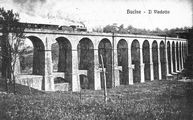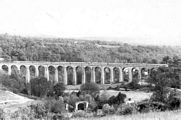|
 |
Bucine Village County
THE ELDERLY AND SOCIETY
Between alienation and prejudice
“THE GREAT VIADUCT ACROSS THE AMBRA RIVER”
“memories, affection, melancholy” |
 |
Listen to our elder people’voice is a participatory fact that enriches people who are not elder for it makes them conscious of a wider significance of human life and the richness that every age brings with itself.
Indeed, there is something that joins each generation: the will to love, fight, dispel both anguish and sadness, the strong need of having someone near to discover life and share experiences, tell past experiences to keep them alive, beacause every moment of every life makes human history.
The bridge, the village and the inhabitants. The history of Bucine citizenship and its “viaduct” is about simple and extraordinary life and deserves eternal memory.
In fact, that bridge has represented for all Bucine villagers several things at a time: progress, dreams, work, fatigue, war and reconstruction. For some of them love, too. As a matter of fact, to rebuild it during Post-Second World War period, workers, such as Friuli carpenters, Calabria and Abruzzo miners, came from many parts of Italy to this Valdarno corner. There were whisperings, meetings, experience shares and then love. For many years, through that viaduct across the Ambra river, thousands of relationships have firstly established, secoundly broken off and lastly established again. After the last war, with the building of the so-called “direttissima”, the Milan-Rome fast railway line for Eurostar trains, Bucine bridge had “a rest”. No more rattling, nor echoing and rumbling of fast wagons through our valleys, from the North to the South. Today, there is enough silence and calm to remember and recall the past.
The “viaduct” was built in 1864 for the Rome-Florence railway line and it appeared a sort of miracle. Stone-masons had worked hard to shape the rock. In the end, a real “masterpiece” came out, with a long series of arches and the bending necessary to the extraordinarily rapid “steam machines” that went far away, towards big cities. The work brought occupation for at least one thousand people. On that tracks, the history ran: the First World War, the “March to Rome” fascists, countriside and Chianti products, the famous Montevarchi hats, etc.
Then, it came the Second World War. That bridge draw to Bucine the Alley planes which bombarded the village without pity. But it was the escaping Nazis that attacked and destroyed the big construction with dynamite. The tunnels nearby, used as munition stores, were blown up in the same way.
During the Post-War period, between famine, misery, mourning and grief, hundreds of workers decided to rebuild the “masterpiece” as soon as possible.
The Bucine symbol must be restored to give everyone the hope of a better future and to link Bucine with big cities again.
In the meanwhile, across the bridge, the trains passed with veterans and wounded soldiers. Each of them, with restored peace, took its usual place in society.
Here, the 2nd of March 1946, the pictures of the “Big Lunch” over the reconstructed bridge. These pictures are extraordinary and speak volumes about the war and the rebuilding of both Bucine and its citizens. At that “Lunch”, there were joyful faces but also worried and doubtful ones. In fact, once the work was finished, “the ghost of unemployment” came forth for several of Bucine bridge builders. However, everyone was there, on the tracks, as if they all together wished to say: “Today, we made history”. It was alike the opening of the Sempione tunnel in the first years of the 20th century or the erection of the many little stations that would “join” Southern to Northern Italy between the 19th and the 20th century. The workers are visible with their flags, spades, shovels, picks, hammers, rocks and scaffolds. The camera pays homage, as it was usual at that time, to the work world”.
Wladimiro Settimelli
Direct witnesses about the old bridge
During last war, one day, I heard a strong bomb blast. I was in Castiglion Alberti and I saw an enormous dust cloud flying away. Immediately, I understood what had happended: the bridge had been blown up. After a few days, I saw it completely ruined, with a train over it, uprooted as if a strong earthquake had cancelled it. Many memories vanished below those ruins, for a sole pillar was still erected and it resembled to a tower. That view caused me a deep sense of scorn towards the responsible of such a devastation together with melancholy for our grandfathers, who had worked for several years to erect it beautiful, strong and perfect.
Dedicated to every children.
(Franco Papini)
Child unconsciousness, I would define it nowadays, when, approximately fifty years ago, I walked across the external edge of the double arch of the old Bucine bridge. Heedless of danger, amusing myself, with the shoulders well fitted onto that strong wall of rock, I went on slowly, looking at the crystal waters of the Ambra River, with its stones, to reach the path that led to the entrance of the Ambra tunnel. Then, continuosly running, I went back, singing, to hear the echo of my voice below those archways that I cannot see now, and each time I pass under the new bridge (everyday) I felt a sense of deep melancholy.
Another beautiful game, for I invented it, was that of entering and exiting in a zig-zag way from the little archs and suddently stopping, to watch the ruins (they had told me) of a remote bridge, which I also enjoy watching nowadays; or to observe how the old stonemill was set in motion by the clean waters of the Ambra River.
The new bridge, rebuilt within a few time after World War the 2nd, it is a real masterpiece but I feel deep affection for my boyhood memories and, for this reason, I still keep on telling that my prefere bridge is the double arch one.
Adele Ciuccoli
Planning: Antonio Becattini (Culture Councillor), Rernigio Mannini (Social Security Councillor), Alfrediana Bonacchi (Professional Educator), Anna Allori (Social Worker).
“The Great Viaduct across the Ambra River” Proget realization: Antonio Becattini, Remigio Mannini, Alfrediana Bonacchi.
Witness research: Antonio Becattini, Alfrediana Bonacchi.
Photographic expertise: Ambra Nepi.
Coordination: Alfrediana Bonacchi.
In collaboration with: County Didactic Director and primary school teachers
Witnesses by: Agnolucci Bruno, Baldi Enzo, Baldi Livio, Baldi Siro, Ballocci Sila, Bartolini Gino, Bartolucci Carlo, Bartolucci Danilo, Becattini Bruna, Becattini Bruno, Bernini Nello, Bindi Nello, Bombardi Enzo, Borri Ivan, Bracci llvo, Brandi Gino, Brandi Sergio, Bucciarelli Natalino, Calchetti Bruno, Chiatti Artabano, Cioncolini Cesira, Ciuccoli Adele, Falchi Alfio, Fuccini Carlo, Gaggi Vladimiro, Genti Dante, Genti Norma Gobbi Enzo, Gragnoli Santi, Graverni Piero, Lastrucci Pier Luigi, Luci Armando, Luci Mario, Merli Guglielmo, Neri Giorgio, Nulli lnes, Nulli Romano, Pagni Giuseppe, Papini Ampelio, Papini Franco, Pieraccini Vitaliano, Pistocchi Luciano, Pistocchi Mario, Pistocchi Orlando,
Sancin Giovacchino, Spaghetti Renato, Stanghini Gino, Stopponi Orlando, Tiossi Luigi, Torrini Pasquale, Valentini Nello.
Iconographical sources: Vestri Photos, for Railway Line Authority: Piero Muscolino, Baldi Siro, Bonci Bruna, Bindi Valerio, Fuccini Carlo, Lastrucci Pierluigi, Mini Zelinda, Rustichini Luisa, Toti Pietro, Layer Dornenico Zampi’s legatees.
Exhibition staging: Becattini Adelmo, Pistocchi Luciano, Mini Bruno, Arrigucci Daniela.
|















